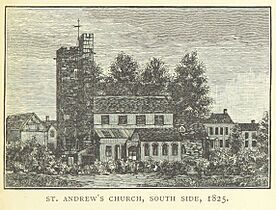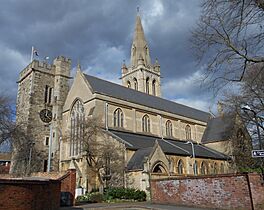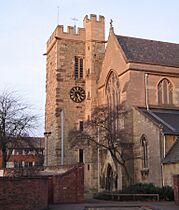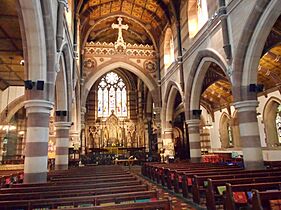St Andrew's Church, Rugby facts for kids
Quick facts for kids St Andrew's Church, Rugby |
|
|---|---|
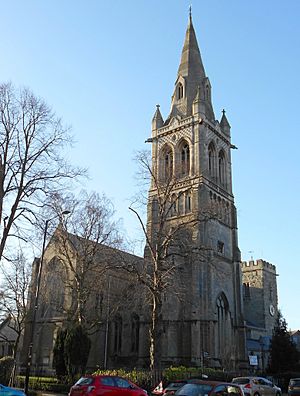
St Andrew's Church seen from the north
|
|
| 52°22′21″N 1°15′41″W / 52.3726°N 1.2614°W | |
| Location | Church Street, Rugby, Warwickshire, CV21 3PT |
| Country | England |
| Denomination | Church of England |
| Churchmanship | Liberal Catholic |
| History | |
| Status | Active |
| Architecture | |
| Functional status | Parish church |
| Heritage designation | Grade II* listed |
| Designated | 11 October 1949 |
| Architect(s) | William Butterfield |
| Architectural type | Gothic |
| Years built | 14th century original but major rebuilding in 19th century |
| Administration | |
| Parish | Rugby St Andrew |
| Deanery | Rugby |
| Archdeaconry | Archdeaconry of Coventry |
| Diocese | Diocese of Coventry |
| Province | Province of Canterbury |
The Church of St Andrew is a special Church of England church right in the middle of Rugby, England. It's not just any church; it's also a "civic church," meaning it plays a role in town events. This church is a grade II* listed building, which means it's a very important historic place. It's quite unique because it has two sets of bells, each in a different tower! St Andrew's is also part of the Major Churches Network. While it has roots in the Middle Ages, it was made much bigger during the Victorian era.
Contents
History of St Andrew's Church
Early Beginnings: Medieval Times
The first mention of a church here was in 1140. Back then, it was a small "chapel of ease." This meant it was a smaller church that helped people who lived far from the main church in Clifton-upon-Dunsmore. In 1221, Rugby became its own parish, and the chapel became a proper parish church.
The original church building is gone. The current church was built on this spot in the 13th or 14th century. The oldest parts you can still see today are the North aisle and the West tower. This tower is about 72 ft (22 m) tall. It looks a lot like a castle tower, which is unusual for a church! People think it might have been built to help defend the town, as well as for religious purposes.
There's a local story that the tower was built using stones from a castle in Rugby. This castle was supposedly torn down by Henry II. He didn't allow private castles without his permission. However, there was no rule against fortified churches. So, the tower might have been built as a church addition, but secretly also as a defense point. The West tower is usually thought to be from the 14th century, but some believe it could be from the time of Henry III (1216–1272). It is the oldest building in Rugby. Inside, you can find other old items, like a 13th-century chest and a medieval font.
Growing Bigger: 19th Century Expansion
As Rugby grew, the church needed to get bigger too. It was expanded several times in 1797, 1814, and 1830. This meant tearing down parts of the older church, and some 14th-century wall paintings were lost.
In the late 1800s, the church was getting old and needed a lot of work. So, it was largely rebuilt and made much bigger. This big project was designed by William Butterfield. Only the West tower and a part of the North side from the medieval church were kept. The main work happened between 1877 and 1879. More additions were made from 1895 to 1896 by Ewan Christian, following Butterfield's plans. This included a new East tower, added in 1895, which has a tall spire that is 182 ft (55 m) high.
What's really special is that both church towers have bells that can be rung! The main set of eight bells is in the East tower. These were made in 1896 by Mears & Stainbank in London. The older set of five bells is in the West tower. These were made in 1711 by Joseph Smith of Edgbaston.
On October 11, 1949, the church was officially named a grade II* listed building. This means it's a very important historic building.
Church Design and Art
The outside of St Andrew's Church is built from cream-colored Bath stone, and its roof is made of grey slate. Inside, you'll see a lot of interesting details, typical of William Butterfield's style. The pillars that hold up the building have bands of cream Bath stone and red Alton stone. The floors and walls are decorated with colorful tiles in red, cream, grey, and black. Many people think the inside of this church is one of Butterfield's best works, showing great skill and beauty. The painted ceiling reaches up sixty feet!
You can also see beautiful stained glass windows, especially the East and West windows, which were made by a company called Clayton and Bell. There are also two narrow windows partly hidden by the organ, and a round "Rose Window" completely hidden behind it.
Near the organ, there's a mosaic artwork. It was likely made by the famous Italian company Antonio Salviati from Venice, possibly with Clayton and Bell.
Between 1909 and 1936, a talented sculptor named Alec Miller created many artworks for the church. He was a leading member of the Campden Guild of Handicrafts. His works include a statue of the Madonna and Child in the Lady Chapel. He also painted the reredos (a decorated screen behind the main altar) on wood. You can also see his amazing wrought iron screens in front of the chancel and Lady Chapel. These works together form one of the largest collections of Miller's art.
The design of the church's East tower and spire looks similar to some of Butterfield's other buildings, like Adelaide Cathedral.
St Andrew's Church Today
Today, St Andrew's Church follows the liberal catholic tradition within the Church of England. This means it has a mix of traditional practices and a more open, modern approach.
Important People Connected to the Church
- Robin Gill, a well-known theologian (someone who studies religion), worked here as a curate (a junior priest) from 1968 to 1971.
- Geoffrey Studdert Kennedy, often called "Woodbine Willie," also served as a curate here before the First World War. He was famous for his work as a chaplain during the war.
Gallery



